
Search Wild Foods Home Garden & Nature's Restaurant Websites:
Lamb's Quarters
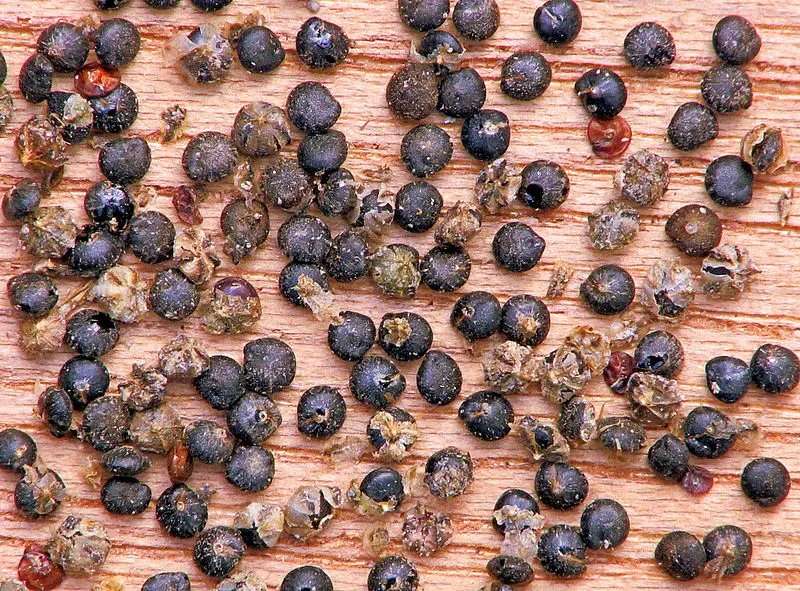
Lamb's Quarters (Chenopodium album) seeds/grain. This grain is uncleaned and needs to be cleaned well before using as food. (By: Rasbak Attribution 2.0 Generic)
(NOTE: If you are not interested in growing Lambs Quarters, but just finding the plant and using it, try going to the Nature's Restaurant Online site for Lambs Quarters).
Lamb's Quarters (Chenopodium album) also called Goose Foot due to the shape of the leaves, is a close relative of spinach. Lamb's Quarters is a traditional food all around the world, and is grown as a crop food in parts of India, just as we grow spinach in the west. It is also a close relative of the Quinoa, the plant that is grown for the Quinoa grain found in health food and now grocery stores. Use the leaves just like you would use spinach leaves.
For many years I grew spinach in my garden. It was always being eaten by something, was beaten down by hard rains and was difficult to get started as the plant was so tender. Then I started growing Lamb's Quarters instead. It is so much hardier and easier to grow. Why did I bother with spinach for all those years? In fact, fresh, young raw Lamb's Quarters leaves even taste better in a salad as far as I'm concerned. The only disadvantage I can thick of is the leaves are smaller and it requires an extra minute of picking to get enough for a meal.
There is even a bonus with Lamb's Quarters. In the fall, when the seedhead is ripe, you can gather and eat the nice and nutty tasting grain - it cooks and tastes like Quinoa, except the grain is not uniformly light tan in color, it ranges from tan to black.
Is the growing of this plant compatible with Natural farming, Ecoagriculture or Eco friendly agriculture, Ecological farming, Sustainable agriculture, Agroforestry or Agro-sylviculture and Permaculture: This plant works very well in a Natural farming, no-till garden environment. You can also use conventional gardening methods. Once established, this plant will re-seed itself if the seedheads are left to mature.
Transplanting: Don't bother trying to transplant a plant larger than 15 cm (6 inches). You have to get a good lump of soil, and not disturb the roots.
Seeds: This plant is a breeze to grow from seed, and that is what I suggest. Find plant in the fall with mature seed, make sure they are dry and store for the winter. Next spring, plant them by scattering seeds over turned over and raked soil. Rake the area lightly after sowing the seeds, tamp the ground, mulch lightly and keep damp until they are started. You will need to thin them out, but the young plants are good to eat stem and all right to about an inch off the ground. This is a plant you can sow in phases from spring to summer to have young tender greens right through the season.
Soil & Site: This is not a picky plant to grow. It takes a wide range of soil types, soil pH, and will grow in full sun to partial shade. It handles drought well, but won't hurt to mulch the ground a little and water if it gets really dry. It will grow better in rich, loose soil, so before you plant turn some composted manure or compost into the soil.
Maintenance: If you are growing just for the greens, and are rotating plants in the garden and don't want this one to come back in the same spot next season, pull the plant out in mid-summer when the greens are no longer good - it pulls out of loose soil without a lot of effort.
Harvesting: The greens are much better on younger plants and there are two very easy ways to tell if a plant is young or mature. On young plants, all the leaves are Rhomboid (diamond) shaped with coarse sawtooth edges or margins. On older plants the upper leaves are smooth edged (Entire) and the leaves are Lanceolate to Elliptical shaped - long, narrow & coming to a point at both ends (not a sharp pointed tip in this case).
The other indicator of how mature the plant is: On young plants the stem is green while on older plants the stem is a pinkish-mauve color. See the pictures below, as this is very clear.
Seeds can be gathered basically the same way as described in the Amaranth section. They are easier overall, as there aren't those itchy hairs that there are with Amaranth. Cook and use just like Quinoa.
Using: To cook the grain: You must first rinse the grain under water to remove any bitterness. Just put in a sieve and run water over it for 30 seconds or so. Then put in a pot with the water, bring to a boil, turn down and let simmer for 15 minutes, turn off heat, fluff it around with a fork, and let sit for another 10 minutes before serving. If it doesn't cook in this time, the grain could be old. Quinoa left for a long time on the shelf will not cook easily and has a darker tan color. With Lamb's Quarters, you will know how old it is if you harvested it. Don't keep for more than a year.
Description:
- USDA Plant Hardiness Zone: 3-10 (More information on hardiness zones).
- Soil pH: 4.5-8.3
- Plant Size: As tall as 3 meters (10 feet), but usually much smaller 20-100cm (8 to 40 inches) is the most common mature size I see in Southwestern Ontario
- Duration: Annual
- Leaf Shape: Varied: lower leaves on mature plants & upper leaves on young plants are Rhomboid (diamond shaped) while upper leaves on mature plants are Lanceolate to Elliptical
- Leaf Phyllotaxis (Arrangement) on branch: Alternate
- Leaf Size: Quite varied: 1-7 cm (inches) long and 0.5-6 cm (inches) wide.
- Leaf Margin: Diamond shaped leaves are toothed, upper leaf margins on mature plants are Entire (no sawtooth on edges)
- Leaf Notes: There is a white powder looking on the green leaves that is more distinct on the lower side of the leaf, but is on the upper side as well.
- Flowers: tiny 5 pointed flowers with double yellow tips
- Fruit: very small (1.5 mm diameter) tan-brown to black seeds that look like a dark color version of Quinoa grain, which is in fact a very close relative.
- Habitat: Open areas (not in shaded woods), disturbed lands, waste areas, ditches, fields, grasslands.
Web Resources:
- Recipe search on the web here (Google search) and here (Bing search).
- Pictures on the web here (Google images) and here (Bing images).
- Interactive USDA distribution map and plant profile here.
- The Biota of North America Program (BONAP) distribution map here. BONAP map color key here.
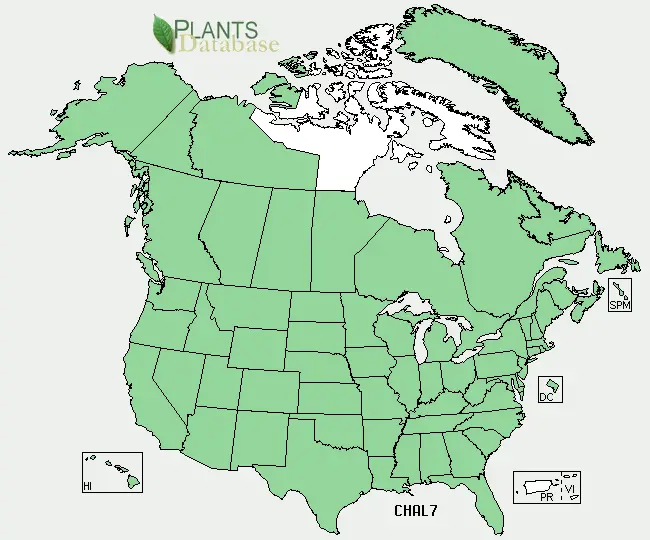
Lamb's Quarters (Chenopodium album) range. Distribution map courtesy of U. S. Department of Agriculture (USDA Natural Resources Service) and used in accordance with their policies.
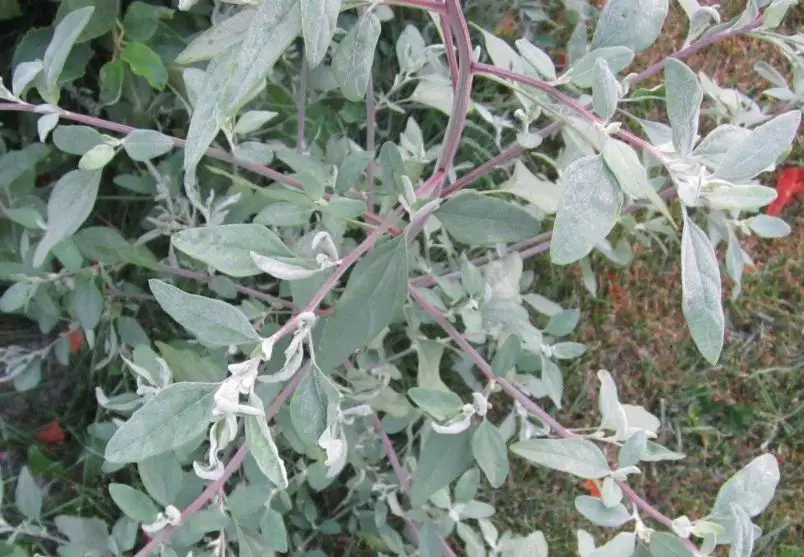
Lamb's Quarters can take many shapes and sizes. The one above is an older plant. Notice how the leaves lose their Goose Foot shape, and become smooth edged (Entire) and Lanceolate and Elliptical shaped . Note the color of the stem.
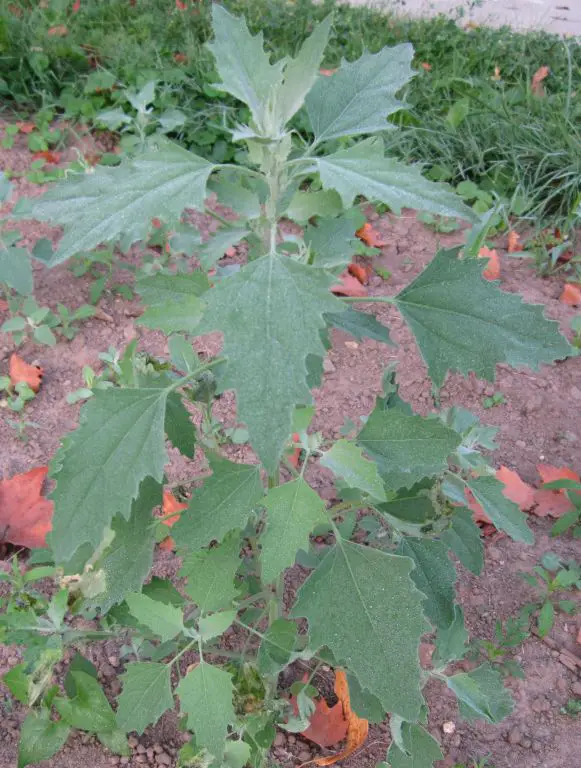
A very young Lamb's Quarters that grew in the open, and is low and wide. This one is choice for eating raw or cooking. Note the stem is green - an indication it is young.
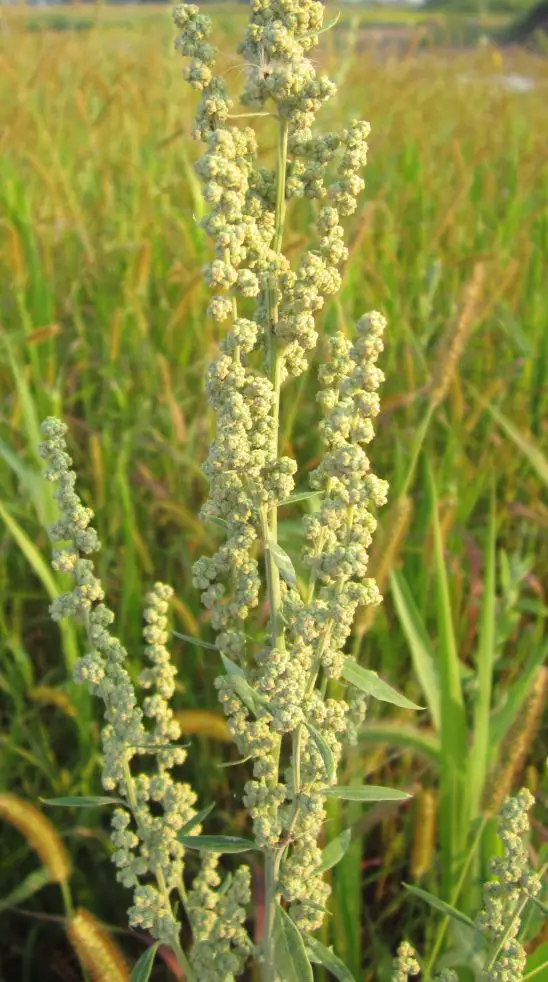
The seed head of the Lamb's Quarters in late August with an amazing crop of Yellow Bristly Foxtail in behind. It is not ripe yet for harvesting the grain. The plant will lose its green color when ready, and it is easy to test by just shaking the seed head over some paper or a bucket. If it is ready some grain will fall out.
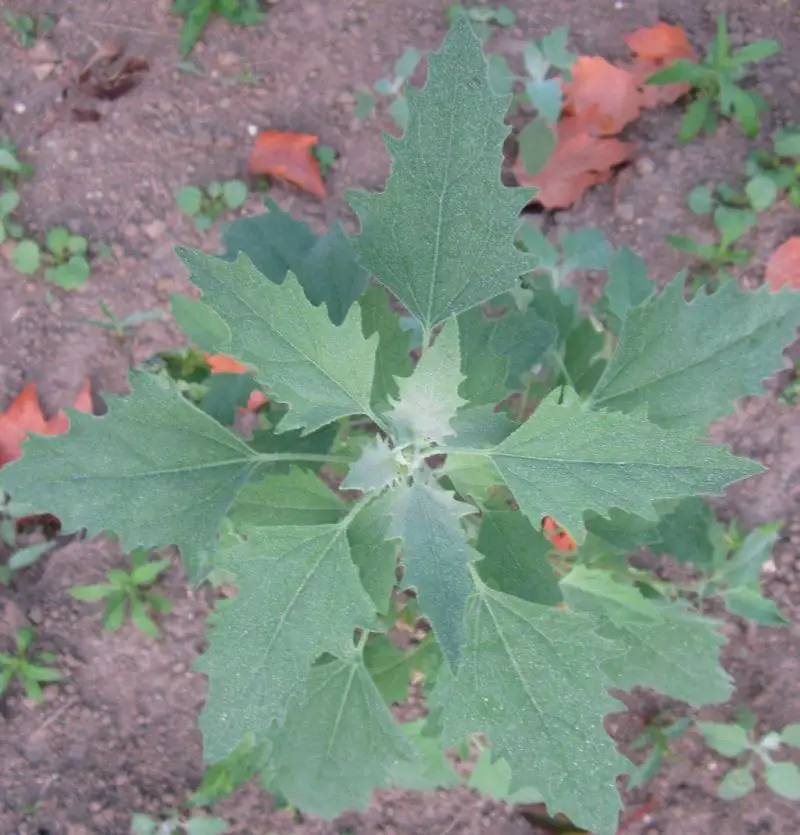
Lamb's Quarters looking straight down on it. This one is perfect for eating the top 9 or so leaves. This is a young plant with leaves that are choice for salads or cooking. Take note of the leaf shape, the plant's other name is Goose Foot.
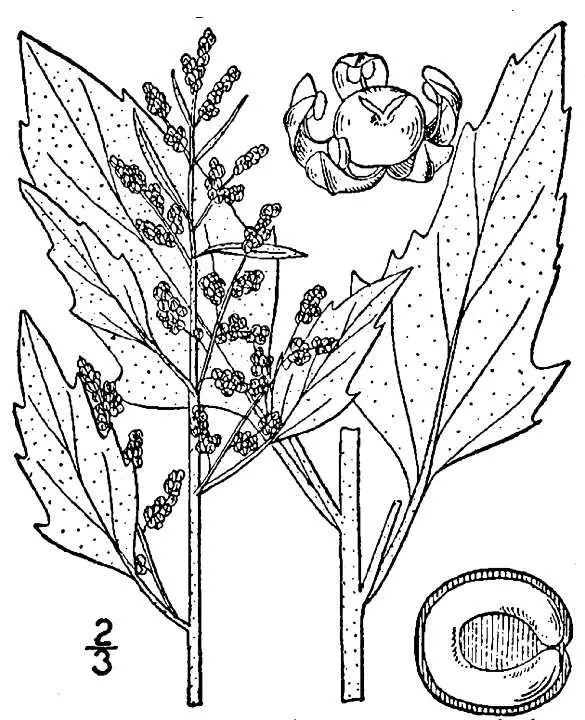
Lamb's Quarters drawing. (USDA-NRCS PLANTS Database / Britton, N.L., and A. Brown. 1913. An illustrated flora of the northern United States, Canada and the British Possessions. 3 vols. Charles Scribner's Sons, New York. Vol. 2: 10)
Search Wild Foods Home Garden & Nature's Restaurant Websites:
Share:
Why does this site have ads?
Originally the content in this site was a book that was sold through Amazon worldwide. However, I wanted the information to available to everyone free of charge, so I made this website. The ads on the site help cover the cost of maintaining the site and keeping it available.
Google + profile
